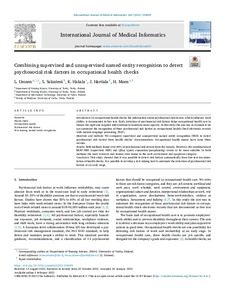Combining supervised and unsupervised named entity recognition to detect psychosocial risk factors in occupational health checks
Uronen Leena; Hakala Kai; Hartiala Jaakko; Moen Hans; Salanterä Sanna
https://urn.fi/URN:NBN:fi-fe2022081154671
Tiivistelmä
Introduction: In occupational health checks the information about psychosocial risk factors, which influence work ability, is documented in free text. Early detection of psychosocial risk factors helps occupational health care to choose the right and targeted interventions to maintain work capacity. In this study the aim was to evaluate if we can automate the recognition of these psychosocial risk factors in occupational health check electronic records with natural language processing (NLP).
Materials and methods: We compared supervised and unsupervised named entity recognition (NER) to detect psychosocial risk factors from health checks’ documentation. Occupational health nurses have done these records.
Results: Both methods found over 60% of psychosocial risk factors from the records. However, the combination of BERT-NER (supervised NER) and QExp (query expansion/paraphrasing) seems to be more suitable. In both methods the most (correct) risk factors were found in the work environment and equipment category.
Conclusion: This study showed that it was possible to detect risk factors automatically from free-text documentation of health checks. It is possible to develop a text mining tool to automate the detection of psychosocial risk factors at an early stage
Kokoelmat
- Rinnakkaistallenteet [19207]
